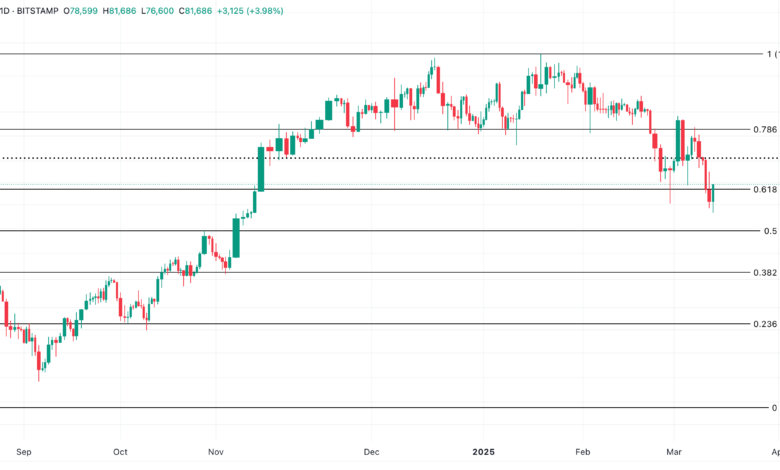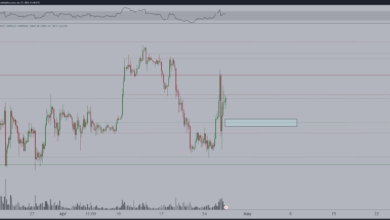
Bitcoin Price Drops Below $80,000 Amid Tariff Tensions
Leading cryptocurrency worldwide, Bitcoin price drop, has just seen a major decline in value, first dipping below the crucial $80,000 mark in months. Rising trade disputes among major world nations, particularly China and the United States, worry investors about this fall-off.
As trade policy uncertainty generates more volatility in world financial markets, investors in the Cryptocurrency Market constantly monitor these swings and the critical pricing levels that can suggest a more profound collapse or a possible return.
Bitcoin Price Drops Amid Tariffs
The price drop for Bitcoin below $80,000 coincided with world markets reeling from declarations of growing tariff policies. Recently imposed levies on imports from the European Union and China by the U.S. government raised questions about a more general economic slowdown. These concerns go beyond traditional markets; the sell-off of impacted cryptocurrencies typically shows considerable sensitivity to world economic developments.

Considered a major threat to the global economy, tariffs can affect trade flows, create consumer and corporate anxiety, and raise commodity prices. This uncertainty sometimes leads investors toward safer assets like the U.S. dollar or gold, which influences price pressure on assets like Bitcoin. Being a volatile asset, Bitcoin reacts strongly to macroeconomic events, so news on this tariff seems to set off a chain reaction in the Bitcoin market.
Bitcoin Price Analysis
Technically, Bitcoin’s price dipping below $80,000 begs questions about possible further losses. Analysts are tracking numerous necessary support and resistance levels that will probably determine the market’s short-term direction.
Regarding Bitcoin, the first primary supportive level is over $74,000. Historically, this level has been a central area of demand; if the price of Bitcoin falls below this level, more significant selling pressure may drive Bitcoin towards the next level of support at $65,000. A drop below $65,000 would likely show a more severe bearish trend; Bitcoin might challenge the $57,000 level, in which case, more notable support is predicted.
Conversely, should Bitcoin remain constant over $80,000, the following important resistance level might be relevant: $87,000. If Bitcoin can surpass this level, it might signal a bearish trend reversal, allowing it to test even higher levels. The price action will most likely determine if additional declines are ahead or if Bitcoin can establish itself at current levels over the following days and weeks.
Crypto Market Downturn
The dip of Bitcoin below $80,000 has not occurred in a vacuum. Other top Crypto Prices have also suffered from the collapse of the derivatives market. For example, Ethereum (ETH) plummeted by more than 10% to about $1,590, the lowest level over a year. Other cryptocurrencies, notably Solana and Cardano, have seen similar losses; many tiny coin values have significantly dropped.
The fall in these cryptocurrencies reflects Bitcoin’s price movement and emphasizes the overall unfavorable attitude influencing the whole Bitcoin market. Since Bitcoin is widely regarded as the bellwether for the whole market, its price changes usually set the tone for altcoins, which are more prone to big volatility due to their lesser market capitalization.
Cryptocurrency Market Caution
A clear reflection of the cautious investor attitude in the bitcoin market is the Fear and Greed Index, which plummeted to depths matching “Extreme Fear.” Reaching 16, the Fear and Greed Index—which evaluates investor mood based on market volatility, transaction volume, and social media trends—showcases general investor uneasiness. This implies that many people are lowering their assets to reduce possible losses or are reluctant to join the market in new roles.
The most excellent liquidation volume since early March 2025—almost $250 million in long positions—has come from their recent liquidation over 24 hours. Driven by worries about more negative market risk, this is evidence of investors responding sensibly.
Macroeconomic Impact on Bitcoin
The price decline in Bitcoin is not only the outcome of internal cryptocurrency events; the larger macroeconomic environment is also quite important. The declaration of tariffs and other trade-related disputes among big world countries has generated uncertainty. Many investors have, therefore, changed their portfolios and turned to less erratic assets for cover.

Global financial markets are intensely entwined; trade policies can affect stocks, bonds, and cryptocurrencies. The larger economic climate will always influence Bitcoin and other cryptocurrencies, even if they are getting more entwined with conventional financial markets.
Bitcoin’s Outlook
Future directions of Bitcoin remain unknown. Though the long-term trend of Bitcoin remains upward despite the recent dip, the cryptocurrency has proven resiliency in the face of earlier market downturns. Still, continuous tariff worries and more general market instability could keep weighing on Bitcoin’s value in the short term.
Investors will have to decide over the next few weeks whether Bitcoin can bounce back or if a more severe bear market is about to develop. They must pay strict attention to important technical levels and stay alert to any further changes in world trade and economic policies that can influence market attitude.
Final thoughts
The paper examines Bitcoin’s recent price decline below $80,000 and links it to growing tariff tensions between the United States and China, which are generating uncertainty in the worldwide market. Bitcoin’s volatility renders it vulnerable to macroeconomic events, so this fall reflects more general economic worries.
Short-term price fluctuations depend critically on key support and resistance levels, including $74,000 and $87,000. The Fear and Greed Index shows that investor attitude has become wary; other cryptocurrencies, such as Ethereum and Solana, have also suffered. The future of Bitcoin is unknown; its movements will rely on the state of the market and the economy.







